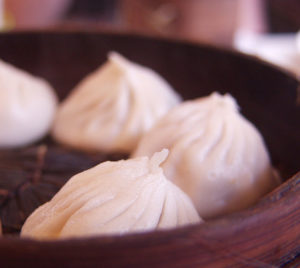
By Brittney Le
AsAmNews Intern
It’s a foodies delight in New York.
The Big Apple now has two museum exhibitions dedicated to Chinese American food: Sour, Sweet, Bitter, Spicy at the Museum of Chinese in America, and Chow at the Museum of Food and Drink (MOFAD). The existence of these exhibitions makes sense in a U.S. today where Chinese food has become much more ‘upscale,’ as many new Chinese American restaurants cater to Americans by claiming to offer both authenticity and quality while moving away from the greasy image of Chinese food.
Chinese American chefs today in New York and across the U.S. have modernized the cuisine to fit the higher standards of

consumers. Chefs put on a show for customers individually handcrafting dumplings daily. The demanding lifestyle of running such restaurants has led to many Chinese Americans leaving their jobs in order to dedicate themselves fully to their culinary endeavors. Former attorney Eddie Huang quit to run BaoHaus in New York’s East Village, where he sells a Chinese stuffed bun called bao. Huang turned his exploits into a memoir which was adapted into “Fresh Off the Boat,” a U.S. television series centered on an Asian American family.
The “Chow” exhibition at MOFAD generated so much excitement the museum raised $91,000 for it through crowdfunding.
“Chinese-American food is a story you can only tell in America, and it’s really beautiful that a fusion food is now normalized,” Mike Lee, the CEO of Studio Industries who served as consultant for the exhibition, told Nikkei Asian Review.
Chinese American food is very different from its Chinese ancestors, as this new cuisine includes more meats, more sauces, and different cooking techniques.
With late nineteenth-century Chinese immigration laws limiting what Chinese immigrants could do for work in the U.S., many ended up working in restaurants and laundromats (read a brief summary of Yick W v. Hopkins: Chinese laundry litigation case here). Many Chinese men thus ended up working in low paying jobs in relatively low-quality Chinese restaurants. Chinese food suffered from stigmas well throughout the twentieth century, as people complained of the adverse health effects of monosodium glutamate (MSG), despite MSG’s use in many popular American fast food chains and multiple studies failing to confirm these fears. Perceptions have changed greatly since these earlier times, as Chinese American food and Chinese fusion foods have deviated quite a bit from these immigrant roots.
However, what does this mean for assimilation, for integration and acceptance of Chinese Americans? Are these Chinese workers required to leave behind the past, to walk away from those immigrant experiences and struggles, in order to gain acceptance from an increasingly demanding American consumer? This decrease in stigmas of Chinese food could be a double-edged sword: Chinese-American food has developed into a wonderfully new cuisine for many to enjoy, leading to greater acceptance of new tastes; but this need for change to have occurred in the first place in order to gain positive recognition may be a sign that the twenty-first century U.S. is still not ready to accept Asian Americans in their entirety, continuing to perpetuate stereotypes that may be forcing people to assimilate their cuisines in order to succeed.
Related: Chinese Food Going Upscale. New Eateries Opening in SF Chinatown
About the Author: Brittney Le is an undergraduate at UCLA majoring in biochemistry with a minor in Asian American Studies.
AsAmNews has Asian America in its heart. We are an all-volunteer effort of dedicated staff and interns. You can show your support by liking our Facebook page at www.facebook.com/asamnews, following us on Twitter, sharing our stories, interning or joining our staff.

